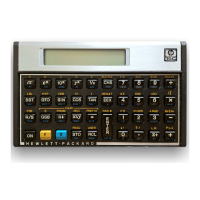
Do you have a question about the HP 15C and is the answer not in the manual?
| Memory registers | 65 |
|---|---|
| Storage media type | - |
| Type | Scientific |
| Cover | No |
| Form factor | |
| Control type | Buttons |
| Product color | Black, White |
| Housing material | Plastic |
| Digits | 10 digits |
| Display type | LCD |
| Display number of lines | 1 lines |
| Battery type | CR2032 |
| Power source | Battery |
| Auto power off | Yes |
| Auto power off after | 5 min |
| Number of batteries supported | 2 |
| Depth | 15.2 mm |
|---|---|
| Width | 129 mm |
| Height | 80 mm |
| Weight | 116 g |
Details on memory size, registers, stack, and nonvolatile memory.
Clears all permanent memory.
Shows memory assignment and initial setup.
Clears all storage registers or prefix key data.
Store X in specified register or recall from storage.
Store, recall, and exchange with index register I.
Access registers using the index register I.
Perform trig/hyperbolic operations and set modes.
Calculate means, standard deviations, and regression.
Inserting code, executing programs via labels and GSB.
Insert labels and set program counter to specified labels.
Set, clear, and test flags for program control.
Increment/Decrement and skip based on register values.
Activate complex mode using 'f I' and deactivate with CF8.
Input real and imaginary parts separated by ENTER.
Perform operations on complex numbers, including trig.
Store/Recall matrix elements using R0/R1 as indices.
Add, subtract, multiply matrices with compatible dimensions.
Calculate matrix division and inverse using LU decomposition.
Finds real root of f(X) using initial guesses.
Integrates function f(X) over a range using GSB calls.
